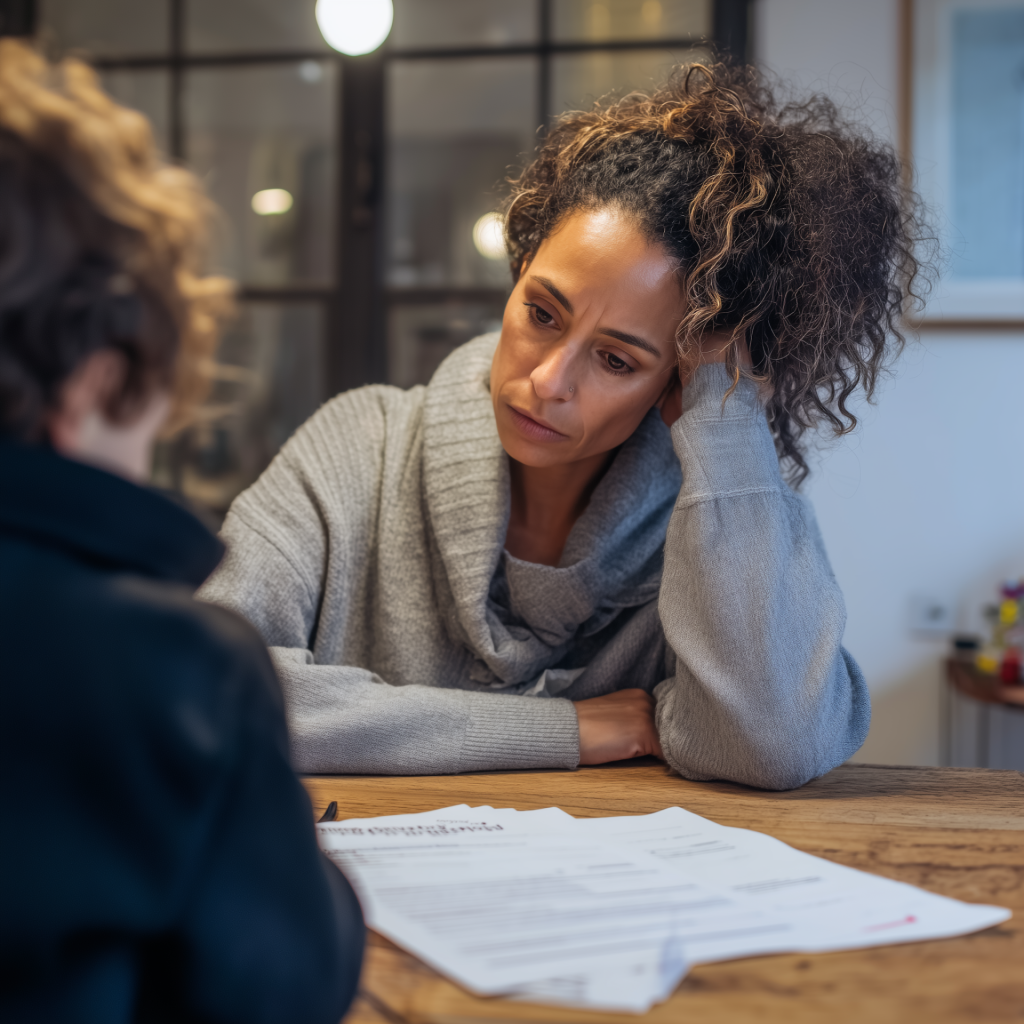As specialist family law solicitors, we are often contacted by parents and carers who are frightened, confused, or overwhelmed after being contacted by social services. In this article, we explain how a social services investigation in the UK works, from the moment a concern is raised to the possibility of court proceedings.
1. What Triggers a Social Services Investigation
A social services investigation in the UK typically begins with a referral, a report made to the local authority about a child who may be at risk.
Sources of Referral
Referrals can come from:
- GPs, hospital staff, nurses, or midwives
- Teachers, social workers, or health visitors
- The police
- Family members, neighbours, or members of the public
- Anonymous callers
These referrals often follow incidents or patterns of concern that suggest a child may not be safe.
Common Reasons for Referral
Social services may become involved when there are concerns about:
- Neglect: including lack of supervision, poor hygiene, inadequate nutrition, or failure to provide medical care
- Physical abuse: including non-accidental injuries like bruises, burns, or fractures
- Sexual abuse or exploitation
- Emotional abuse or exposure to repeated domestic violence
- Parental substance misuse or unmanaged serious mental health conditions
- Unsafe home environments that pose a risk to the child
- Pre-birth concerns, where unborn babies are at risk due to domestic violence, drug use, or past child protection history
Legal Duty to Investigate
Under the Children Act 1989, local authorities have a duty to investigate:
- Under Section 17 if a child is deemed “in need” of support services
- Under Section 47 if there is reason to suspect that a child is suffering, or likely to suffer, significant harm
This legal framework requires social services to assess each situation carefully to decide what action, if any, is necessary to safeguard the child.
2. The Initial Referral & Screening Stage
Once a referral is made, children’s services must quickly assess how to respond. A referral is simply a report that a child may be at risk of harm, sent to the local authority’s children’s social care team.
What Happens When a Referral Is Received
When we refer to a social services investigation in the UK, the process usually starts here. The local authority must decide, often within 24 hours, whether the situation requires:
- No further action
- A Child in Need assessment under Section 17 of the Children Act 1989
- A Child Protection investigation under Section 47 if there is a risk of significant harm
This early decision is known as screening, and it determines the direction of the case.
Determining the Level of Concern
Social workers consider:
- Is the child in immediate danger?
- Is there a likelihood of significant harm?
- Or is the child in need of support but not at immediate risk?
The aim is to prioritise the child’s safety while using the least intrusive response necessary.
Initial Checks
Before deciding how to proceed, the social worker gathers key information, including:
- Details from the referrer
- Any known history with social services
- Information from the child’s school, GP, or health visitor
This initial step helps determine whether the concerns are serious, whether the family has support needs, or whether the referral should be closed at this stage.
3. Formal Assessment Stages
If the local authority determines the concerns require further action, they will begin either a Child in Need assessment or a Child Protection investigation, depending on the level of risk.
Child in Need Assessment (Section 17)
This applies where a child is not at risk of significant harm but still needs support to achieve a reasonable standard of health or development. These assessments:
- Involve discussions with the family, home visits, and information from schools and health professionals
- Are typically completed within 45 working days
- May lead to a Child in Need plan, which outlines services and support available to the family
This pathway focuses on early help and support, rather than legal intervention.
Section 47 Investigation (Child Protection Enquiry)
A Section 47 investigation begins when there is reasonable cause to suspect significant harm. This is a more urgent and structured process.
Key steps include:
- A strategy meeting with other professionals (e.g. police, health, education) to plan the investigation
- Home visits and private interviews with the child (where appropriate)
- Gathering information from doctors, schools, and others
- Assessing parenting capacity, home conditions, and the level of cooperation from carers
Timeframes are shorter in urgent cases. The aim is to gather sufficient evidence to decide whether the child is safe at home or further action is needed.
4. What Happens During the Investigation
Once a formal investigation begins, social workers take active steps to gather evidence and assess the child’s situation.
Home Visits and Observations
Social workers will visit the family home, sometimes more than once. During these visits, they assess:
- The child’s living conditions (cleanliness, safety, space)
- Whether the child appears well cared for (clothing, hygiene, nutrition)
- Parental supervision and awareness of the child’s needs
- The home environment, including any signs of neglect, risk or danger
Their observations help determine whether the child is safe to remain at home or if protective measures are needed.
Interviews and Information Gathering
As part of the social services investigation in the UK, the social worker may:
- Speak to the child alone, if they are old enough
- Interview the parent(s), carers, and other household members
- Contact teachers, GPs, health visitors or any other professionals involved with the family
The aim is to build a full picture of the child’s experiences and any risks present.
Multi-Agency Collaboration
Social services rarely act in isolation. During the investigation, they work closely with:
- Health professionals (e.g. GPs, paediatricians, mental health teams)
- Education providers (nurseries, schools, SEN coordinators)
- Police, particularly in cases involving suspected abuse or criminal behaviour
This joint approach ensures that no safeguarding concern is overlooked.
Safety Planning
If concerns are identified, a safety plan may be put in place. This could involve:
- Asking another adult to temporarily supervise contact with the child
- Providing support services while further assessment continues
- Seeking an Emergency Protection Order (EPO) if the child is in immediate danger
- Arranging for a child to stay with a family member or foster carer while concerns are addressed
Our role is to ensure your rights are protected during this process, and that decisions are made fairly and lawfully.
5. Parents’ and Carers’ Rights & Responsibilities
It is vital that parents understand both their rights and responsibilities during any social services process.
Your Right to Be Informed
You have the right to be told:
- The nature of the concerns raised
- What assessments or investigations will take place
- The outcome of any decisions made
Social workers should explain this clearly and allow you to respond.
Your Right to Legal Advice
If you are subject to a social services investigation in the UK, we strongly recommend that you seek legal advice as early as possible. At ASA Solicitors, we can help you:
- Understand the allegations
- Respond appropriately
- Prepare evidence to support your case
You may be entitled to legal aid depending on the nature of the case.
Your Responsibility to Engage
While you are not legally obliged to cooperate, failing to engage may raise further concerns. We always advise clients to:
- Be respectful and open with professionals
- Keep a record of all meetings and communications
- Provide any requested documents (e.g. school reports, medical letters)
You also have the right to challenge inaccurate information or to present counter-evidence where appropriate.
Confidentiality and Data Sharing
Social workers must follow data protection laws. However, information may be shared between agencies involved in safeguarding. You are entitled to ask what data is being shared and why.
6. Possible Outcomes Before Court
Not every social services investigation in the UK results in legal action. Depending on the level of concern and the family’s ability to make changes, several outcomes are possible before court proceedings are considered.
No Further Action
If the investigation finds no evidence of significant harm or ongoing risk, the case may be closed without further involvement. This often happens where:
- The referral was based on a misunderstanding
- The child is already well supported and safe
- Concerns have been quickly resolved
In this case, you will receive written confirmation and social services will take no further steps.
Child in Need Plan
If a child is assessed as needing additional support but is not at risk of harm, the local authority may create a Child in Need Plan. This outlines the help to be provided, which may include:
- Parenting support
- Help with housing or finances
- Educational support
- Access to health or counselling services
These plans are usually voluntary and reviewed regularly.
Child Protection Plan
If a child is found to be at risk of significant harm, a Child Protection Conference may be held. If the professionals involved agree, the child will be made the subject of a Child Protection Plan.
This includes:
- The concerns identified
- What needs to change to reduce risk
- Actions and support expected from the parents and agencies
The plan is closely monitored, and reviews take place every three months.
Voluntary Agreement (Section 20)
In some cases, the local authority may ask parents to agree voluntarily for their child to live elsewhere under Section 20 of the Children Act 1989. This is not a court order, but legal advice is essential before agreeing.
You have the right to withdraw your consent at any time unless a court order is later made.
Emergency Measures
If a child is believed to be in immediate danger, emergency steps may be taken. These include:
- Emergency Protection Order (EPO): grants the local authority temporary parental responsibility for up to 8 days
- Police Protection Order (PPO): allows the police to remove a child to a place of safety for up to 72 hours
- Interim Care Order: used during care proceedings to remove a child temporarily while the case is ongoing
We provide urgent legal advice and representation in all such emergency situations.
7. When Cases Move to Court (Care Proceedings)
If the local authority believes that a child is not safe at home and that voluntary arrangements are not working or appropriate, they may apply to the Family Court to begin care proceedings.
What Triggers Court Proceedings
Proceedings are usually initiated when:
- A Child Protection Plan has not led to improvement
- There is serious or repeated non-cooperation from parents
- Immediate danger cannot be managed through voluntary measures
- The local authority believes the child cannot remain safely at home
In these cases, the council will apply for one or more legal orders under the Children Act 1989.
Legal Orders Used in Court
Several different orders may be sought depending on the circumstances:
- Interim Care Order (ICO) – temporarily gives the local authority parental responsibility while the case is ongoing
- Care Order – grants the council long-term parental responsibility, allowing them to decide where the child lives
- Supervision Order – the child stays at home, but social services oversee their welfare for a set period
- Emergency Protection Order (EPO) – short-term emergency removal of a child
- Placement Order – allows the local authority to place a child for adoption
- Special Guardianship Order – places the child with a relative or carer on a permanent basis
We act for parents and family members in all types of care proceedings and can help you understand the best course of action for your situation.
The Public Law Outline (PLO) Process
Before care proceedings begin, the local authority must usually follow the Public Law Outline (PLO) process. This includes:
- Sending a PLO letter (also called a pre-proceedings letter) explaining the concerns and what changes are expected
- Inviting you to a PLO meeting, where you have the right to legal representation
The purpose is to give families a final opportunity to make changes and avoid court.
Court Hearings
If the case does go to court, there will be several key hearings:
- Case Management Hearing – sets the timetable and identifies key issues
- Issues Resolution Hearing – the court considers if an agreement can be reached or whether a final hearing is needed
- Final Hearing – the judge decides where the child should live and what legal orders are necessary
The Role of CAFCASS and the Children’s Guardian
In all care proceedings, the child is separately represented by a solicitor and a Children’s Guardian appointed by CAFCASS (Children and Family Court Advisory and Support Service). Their role is to:
- Represent the child’s best interests
- Investigate the case independently
- Make recommendations to the court about what should happen
We work alongside Children’s Guardians but ensure our clients’ voices are heard at every stage of the process.
8. Timeline: From Referral to Final Hearing
A social services investigation in the UK can move quickly, especially if there are urgent safeguarding concerns. However, where possible, the process is structured around clear timeframes to ensure fairness and avoid unnecessary delay.
The Pre-Proceedings Stage
The PLO (Public Law Outline) process gives parents an opportunity to work with the local authority before court is involved. This stage may last several weeks, with:
- A formal PLO letter outlining concerns
- At least one PLO meeting with your solicitor
- A review of progress before court action is taken
If no sufficient change is made, or if the situation deteriorates, the local authority may then issue proceedings.
9. Possible Outcomes in Court
At the end of care proceedings, the Family Court will make a decision based on the child’s welfare. The possible outcomes include:
Child Remains at Home
If the court believes the child can remain safely with a parent or carer, this may be under:
- No order – the case ends without restrictions
- A Supervision Order – where social services monitor the child at home
- A Child in Need Plan – with agreed support services
Temporary Removal
The court may decide the child should live elsewhere temporarily under an Interim Care Order, with:
- A foster carer
- A relative or kinship carer
- In residential care (less common)
This arrangement is usually reviewed regularly.
Long-Term Removal
In serious cases where the child cannot return home safely, the court may make a:
- Care Order – giving the local authority parental responsibility until the child is 18
- Placement Order – allowing the child to be placed for adoption
Special Guardianship Order (SGO)
This places the child with a relative or other suitable adult permanently, without adoption. It gives the guardian enhanced parental responsibility, while maintaining some legal links to the birth family.
Contact Arrangements
If a child is removed from parental care, the court will usually make decisions about contact with parents or other family members. Contact may be supervised or unsupervised, depending on the circumstances.
10. What to Do If You Are Involved
If you are the subject of a social services investigation in the UK, there are important steps you can take to protect your position and demonstrate that your child is safe and well cared for.
Get Legal Advice Early
Do not wait until court papers arrive. Contact a solicitor as soon as possible. At ASA Solicitors, we can advise you from the very first meeting with social services.
Keep all relevant documents that show your ability to parent safely, including:
- Medical records
- School reports
- Character references
- Attendance records from support services
Cooperating with professionals can make a major difference. Attend all meetings, follow agreed plans, and show that you are willing to make positive changes where needed.
Make a note of all interactions with social workers, meetings, advice given, and any steps you’ve taken to address concerns. These can be useful if the case progresses to court.
You are entitled to:
- See the concerns raised against you
- Respond with your own evidence
- Be represented in meetings and court
- Appeal certain decisions
We will make sure your rights are upheld throughout.




